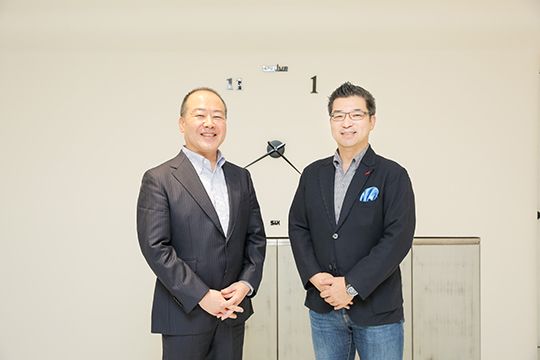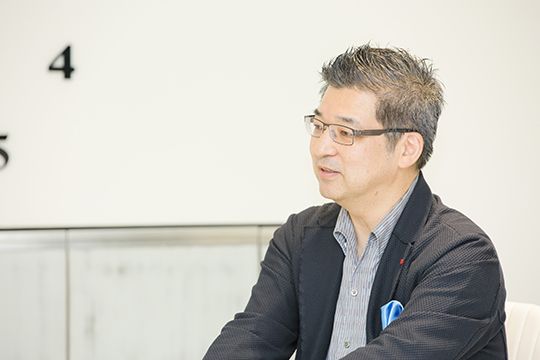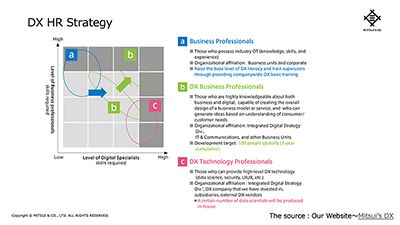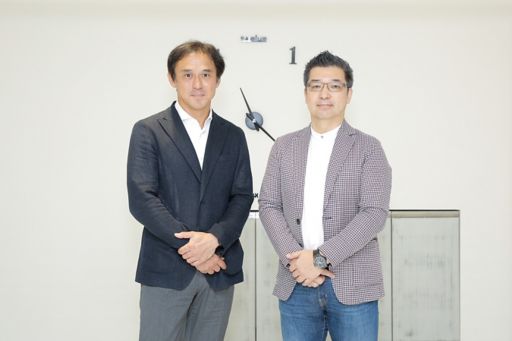”Large companies are the ones that need to seriously work on digital management” --- we hear a lot of similar opinions today, especially after the pandemic. There are actually corporations currently working on this challenge, including those that have already paved their way for transformation.
What kind of path did these companies follow? What kind of future are they seeing? And what are the company’s unwavering fundamentals that can be found? --- In this article, we will introduce the discussions conducted between Yuji Mano from Mitsui & Co., Ltd.’s Integrated Digital Strategy Division and Masayuki Chatani from KPMG Ignition Tokyo.
How Did Mitsui Implement DX Basic Training Across the Organization?

(Yuji Mano, Managing Officer, General Manager of Integrated Digital Strategy Division of Mitsui & Co., Ltd. (left), Masayuki Chatani, Representative Director & CEO of KPMG Ignition Tokyo and CDO of KPMG Japan (right)) *Professional affiliation and official position in the article are at the time of publication.
Chatani: While our KPMG Ignition Tokyo has 60% of members with global background, I believe that their Japanese skills are also important if they do business in Japan. There are many companies promoting English first policy, but we are discussing the possibility to go beyond that to implement a multi-language policy.
Of course, being good at English is a great advantage in the internet and computer field, but when someone cannot speak Japanese, he or she will only get secondary information. In my opinion, they are missing opportunities when they are not able to directly understand what their clients or colleagues really want to do. The people in b category you had mentioned in the previous discussion (refer to the Vol. 1) might play a role of an interpreter, but if people in a and c categories work together, talent b would be able to focus on products more (refer to the image below "DX HR Strategy").
Mano: Yes, that is true.
Actually, the blue arrow pointing to the right from category a represents an improvement of capacity by the company’s DX basic training. To achieve this, we have set up a skill training course called “Foundation 1.” It is our original course that takes 4 hours to complete. We first declared to every officer and employee including the president that “this course is targeted at all officers and employees including our president and new hires --- everyone needs to complete it and pass the exam.” We also mandated completion of the course by everyone in 3 months or less. Because of the declaration, 100%, or approximately 5,500 employees from the chairman to new hires, completed the training before the deadline of August 31.
Chatani: That is incredible. Was there any “resistance”?
Mano: Yes, there was. It may sound unsophisticated, but we had posted % of completion by business unit and corporate division on our intranet every day in real time. We used this approach to create a sense of urgency and competitive mood. Also, the top management, including the chairman and the president, proactively completed the training, so I assume other employees felt compelled to follow them.
We are going to introduce this same training to our affiliates and implement the English version to overseas affiliates. Ultimately, we are planning to complete training for all 45,000 people who are related to Mitsui & Co.
Chatani: That is a grand scheme. Do you select the curriculums for the training in-house?
Mano: We had created only the first “Foundation 1” in-house. This is because we wanted to tell our employees what Mitsui’s DX Comprehensive Strategy is about. We also needed to compile information relating to the following questions in an easy-to-understand format --- “why digitalization is necessary in our environment today in the first place?”, “what are the examples of digital technologies actually pertinent to today’s digital needs?” and “what kind of process would promote our project?”
After completing this training, if the trainee wants to further pursue certain tools or technologies, he or she can move on to a next step by voluntarily utilizing “UdemyTM”, the online education platform, as “Foundation 2” course.
Chatani: Planning and developing educational materials require resources and skills. Did you create a new team for this?
Mano: We had created DX Human Resource (HR) Development Department within our Integrated Digital Strategy Division a year ago. This area is normally the responsibility of the Human Resources & General Affairs (HR & GA) Division, but HR isn’t necessarily well-versed in this area. So, DX HR Development Department took charge of creating the educational materials while resources of the HR & GA Division carried out actual operation of the program. Likewise, for assessment process of the certification program, DX HR Development Department will primarily take the charge, while cooperating with the HR & GA Division as well as the Corporate Planning & Strategy Division.
Chatani: I see. We can learn a lot from other company’s people development approach.
Now, I would like to take this opportunity to briefly explain our people development at KPMG Ignition Tokyo. KPMG Japan offers three types of business services, namely audit, tax and advisory. Under these three business categories, there are corresponding six pillars --- secure computing, knowledge processing, intelligent agent, scientific visualization, smart transaction, and edge computing & IoT.
We have professionals such as data scientists and engineers in each pillar, who make up a group called “guild” that transcends the boundaries of these pillars.
For example, we have data AI guild, software engineering guild, UX guild and so on.
Guild leaders are responsible for development of persons who have the same expertise as theirs in their guild. We ask them to create plans such as “we will develop this person through this kind of project” or “have this person join in this type of conference to learn so and so things”, etc., and then allocate budgets to these plans. This project started last year and will fully take off within this year. Our goal is to bring people who are nearly digitally native to a world-class level, but we are still in the process of finding a way to accomplish this.
Mano: I see. We are also in the process of finding the way. Our Integrated Digital Strategy Division was established in October 2019. Prior to this, the IT Promotion Division, which was responsible for IT, and the Digital Transformation Team of the Corporate Planning & Strategy Division, which was responsible for DX, worked separately. I had been thinking that the IT Promotion Division and the Digital Transformation Team should be combined, not separated, otherwise we would not be able to put any plan to implementation. So, we started aggregating management functions for individual systems, which had been dispersed in small units in each department, into the Integrated Digital Strategy Division in April 1, 2020.
We could say that, in a way, it was a forerunner for the concept of the government’s Digital Agency. It is a division that aggregates all the functions — whether it be digital or IT — that had been dispersed across our company, into a single place. The division has DX1-3 departments referred to as the “front” and 8 other departments, each with different functions, called “COE (center of excellence).”
These “front” DX1-3 departments are positioned as teams that respond to overall needs of various business units and their affiliated companies. Their role is to absorb all needs of business units and address their general requests such as “we want to use AI”, “we want to start this particular type of new business”, “ERP of our affiliated company does not work” or “how should we invest in IT or use human resources.” Based on the content of individual request, they will then work with relevant COE department (relevant function) to form an optimal team to work on the projects.
I felt that this work flow is similar to the guild you had mentioned earlier. For example, the Digital Technology Strategy Department, one of the COEs, has many talents with master’s degree in AI, and the Data-Driven Management Strategy Departments is a team specialized in data. Corporate DX 1st and 2nd Departments have specialists in mission-critical systems/data for various executions including ERP and non-financial systems/data such as HR and sustainability, respectively. Furthermore, we have network/cybersecurity specialists in the Digital Infrastructure Department and UI/UX specialists in the User Experience Reform Department. Although these departments exist separately, they work together flexibly across the boundary with relevant front departments to achieve the goal of each project. We also have 5 international satellite locations for the Integrated Digital Strategy Division in New York, London, Singapore, Shanghai and Sao Paulo, which hold a total of 200 specialists.
Chatani: That is such a grand scale!
Collaborating with Outsiders Prevents “Reinventing the Wheels”
Chatani: I have heard that Mitsui & Co., is working together with various other companies while also working internally to establish the foundation for digital-driven management. You have a joint-venture company called GAILABO with Sony’s affiliated group company. As a company actively collaborating with players in various other fields, how do you decide whether to work internally or collaborate with third parties?
Mano: It’s not a matter of deciding between the two. We retain both choices.
Internally, we work on improving the overall capacity level of the company by promoting people development. But again, because we are a general trading company, it is difficult and time-consuming to do everything on our own.

To keep up with the speed of today’s business, there are cases where it is better to aggressively increase collaboration with third parties. We work with SONY, our partner in GAILABO, Preferred Networks and AI Fund, a team organized by Andrew Ng, under the vision of “developing a new society through utilization of AI.”
I believe the most important thing for us as we promote the digital field in the future would be how much we will be able to expand our external network while also developing internal talent. Otherwise, we might fall into the dilemma of so-called “reinventing the wheel” where people work hard on making something that has already been invented by someone else.
Today, there are numerous start-ups and countless SaaS players. If this is the case, it would be more efficient for us to learn about them and capitalize on each other’s strengths. It helps increase our speed, so, this is why we are working on expanding our network.
However, even when we have the desire to work with a particular partner, this may not be necessarily reciprocated by the other party. We may not be a desirable partner unless we have built up our internal capacity. This is why I think both external and internal are equally important.
Difficulty of Finding External Partners and Difficulty of Convincing Internal People

Chatani: Do you have a team dedicated to finding third-party partners?
Mano: In the past, we had created “Innovation Promotion System” in 2012. Back then, we already had the public image that “trading companies are far from being innovative.” However, I thought this is all the more reason to bring innovation to our company.
It did not go smoothly at first, but we had learned in the process that “if we want to bring innovation, we have to work with various different people, especially those with great capacity.” So, we had started expanding our actions since around 2017.
We made an investment in Preferred Networks for the first time in 2017. After 5 years of our works that date back to 2012, we came to a belated realization that “Preferred Networks is a very interesting company.” Yet, at the time, most of the people at a trading company had no idea what AI was, thus we had invested without exactly knowing what they were about. We have accumulated our knowledge ever since and expanded our network to date.
Chatani: I assume it was not easy to convince people inside your company about this investment decision.
Mano: There had been a heated debate. Mitsui & Co., is a company with stronger expertise and experience in heavy industries such as steel, mining, oil, power generator, etc. Until then, our company considered the following process as the normal investment procedures --- first, estimate a project life (for example, 15 years), derive cash flow, convert it to the present value and calculate IRR %. Of course, there are still some areas where this method is useful.
However, when we invest in something like Preferred Networks, it is impossible to estimate the cash flow for 15 years. We need to think what we should do when investing in an extremely uncertain project. So, I had set up a system that enabled this decision-making process, and also analyzed the new business environment at the same time. In spite of these, there were still uncertainties that were difficult to judge. So, at the end, the general manager of the Corporate Planning & Strategy Division and the top management had “taken the plunge” and made the decision.
Chatani: There must have been much hesitation before reaching to that conclusion.
Mano: Yes, of course. There had been negative reactions questioning the reasonableness of investing in an unfamiliar company. As Warren Buffet from Berkshire Hathaway stated, the right way is to “invest only in things you can understand.” But at the same time, it might be too late if we wait until we can understand things. Sooner or later, we had to leap ahead over old customs at some point. Of course, we had conducted various analyses and collected information in the meantime, but we had to do that “jump” in the end. I believe we had been able to discern that “time to jump” in around 2017.
Chatani: 4 years have passed since then. Do you feel that you have reached the target you were aiming for?
Mano: I believe that our initiative has just started. There will be many more powerful companies to emerge, but we cannot wait for them. So, we will be making investment judgments whenever we find opportunities relevant to us. We will also start creating new businesses with our partners.
As for investment decisions inside the company, we need to tell our people that “just using conventional indices and calculations such as IRR and NPV method will not be enough anymore. From now on, we need to start using approaches such as LTV (life time value), CAC (customer acquisition cost), etc.” Conventionally, our business investments and resource investments had been made with a notion that they must win virtually 100% of the time. I need to make my people realize that this is not the case. To change their awareness, we need to be changing our decision criteria.
Chatani: That sounds like a difficult thing to do.
Mano: It is difficult. This thinking is ingrained in our company. I assume this is because there are many people in a trading company who believe in MBA approach that cannot be changed easily.
A little while ago, I came to an eye-opening realization. When I asked someone what venture companies do, he answered (though I am afraid it may sound offensive to some people in the venture business) “ventures are those who put simple ideas into actions, successively one after another, at incredible speed. Large corporations today are unable to keep up with this speed.”
When I brought up this idea in the conversation with another venture capitalist and asked “if large corporations acted on the same thinking as speedily as ventures, do you think they will win?” He said “yes, they will.” He also said “their capital strength is greater, so if they really can do the same thing, they will surely win.” When he said that, I realized “that is so true!” It’s a matter of whether we can or cannot commit ourselves to their level.
Profile of Interviewee

Yuji Mano
Managing Officer, General Manager of Integrated Digital Strategy Division
Mitsui & Co., Ltd.
Yuji Mano joined Mitsui & Co. in 1986, and was engaged in chemical sales in Japan and the United States, then transferred to Corporate Planning & Strategy Div., formed the company-wide Information Strategy Task Force in 2008 and served as the leader, and he became the first General Manager of the Information Strategy Planning Dept. in 2009. After that, he served as General Manager of Chemical Business Development Div., CAO of Mitsui Americas, and then General Manager of IR Div. in 2016. He became a managing officer in April 2019 and was General Manager of IT Promotion Div. in June of the same year. He advocated the integration of DX and IT in business strategy, and became General Manager of Integrated Digital Strategy Div., which was established as the integration of two organization in October, 2019. After that, all DX / IT related organizations that had been dispersed throughout the company were also integrated to carry out large-scale organizational restructuring, which resulted in establishment of the current Integrated Digital Strategy Div. He formulated "DX Comprehensive Strategy" and promoted digital transformation, data-driven management and DX human resources strategy for the entire Mitsui & Co. Group.
Follow us on KPMG Ignition Tokyo LinkedIn for the latest news.
Connect with us
- Find office locations kpmg.findOfficeLocations
- kpmg.emailUs
- Social media @ KPMG kpmg.socialMedia






